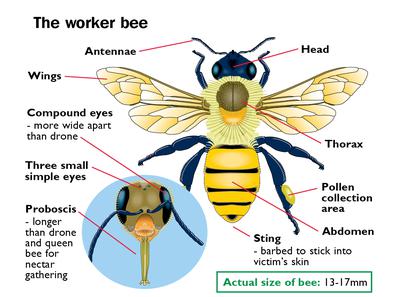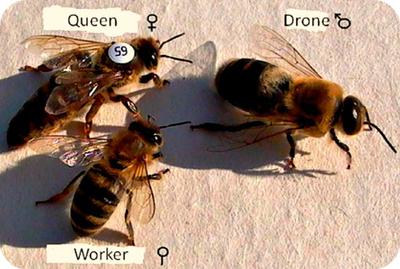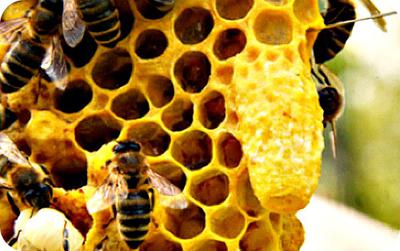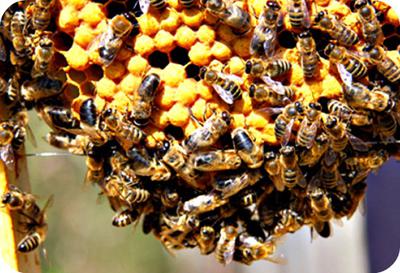VANILLA BEANS | SOYBEAN OIL | SOYMEAL & CAKE | COCOA BEANS | COFFEE BEANS
The Science of Bees & how they behave in Uganda, Africa

The Structure of a Worker Bee
There are various types of bees in Uganda Africa which include the stingless bees, solitary bees, honey bees.
This Guide focuses on honey bees.
Honey Bees belong to the animal kingdom, Phylum Arthropoda, Order Hymenoptera, class Insecta, Super
family Apoidea, family Apidae, genus Apis. The genus Apis is divided into several species and sub-species/
races but the 5 main species are: Apis dorsata (the giant honeybee), Apis laboriosa (the darker giant honeybee),
Apis florea (the dwarf honeybee), Apis cerana and Apis mellifera. Research needs to be done to
ascertain the major species available in Uganda.
Castes in a bee colony
Honey bees are social insects that live in colonies of 10,000 to 60,000 bees. A colony consists of a queen (fertile female),
a few hundred drones (males) and thousands of workers (sterile females). They pollinate flowering plants and crops.
Queen bee
The Queen bee is a reproductive female. There is only one queen in the hive and her job is to lay eggs and
produce queen substance (pheromones). When a new queen starts life, she mates only once with drones outside the hive.
A good queen lays between 1,500 - 2,000 eggs per day but after two years she lays fewer eggs.
She lives for three to five years. It is very difficult to find the queen but she can be recognized by her long and
slender body and short wings. She is fed by the young workers and is bigger than the other occupants
due to massive feeding especially with royal jelly. She has a sting that is only used against rival queens.
Her pheromones or scents serve to control the other bees and harmonize the colony’s behaviour.
The Queen bee can be marked on the dorsal surface of the abdomen for easy identification and to avoid being crushed
accidentally during hive manipulations.
Click Here to Buy/Sell Hive products and Beekeeping Equipment
.Drones
The Drones are males and are bigger than the workers. They develop from unfertilized eggs and their major task is to
mate with the queen. They are stingless, very large eyes which are used to spot the Queen during mating.
Drones look large and square and make a loud buzzing noise when they fly.
Drones are dependent on the workers for food because their proboscis is short and cannot collect food for them.
There can be about 200 to 500 drones in a hive but in time of food shortage the workers chase the drones out of the hive
to die. Their lifespan is usually not more than 2 months.
Click Here to Buy/Sell Hive products and Beekeeping Equipment
.The Workers
Most of the bees in the hive are workers- they are all sterile females.
The worker bees’ change tasks according to age. Young worker bees clean the hive, feed both young and
the Queen and make the beeswax combs.
They control the temperature of the hive by flapping their wings and also guard the hive. Older workers scout for food
and collect the pollen, nectar, water and propolis.
They have a sting plus special glands and organs to help them to defend the colony against enemies.
The workers are also responsible for the honey formation process.
The lifespan of a worker bee is 7-8 weeks during the main flowering season when they work hard.
They can live longer during dormant periods.
Click Here to Buy/Sell Hive products and Beekeeping Equipment
.Communication in bees
Bees communicate with one another in a number of ways such as drumming feet, flapping wings like a ‘dance’
and use of pheromones. The dance performed by the scout bees is one way the bees inform each other of the location of
food and how far away it is. There are several types of dances performed by the bees, but the main ones are the round
dance and the waggle dance.
The round dance is performed by bees that forage less than approximately 100 metres from the hive.
Waggle dance is performed to locate food source beyond 100 metres from the hive. The scout bees also perform a
characteristic dance to locate the new found home to which bees intend to swarm.
The queen releases a substance called a “pheromone” (sometimes called queen substance) which serves different functions.
The pheromone enables her to identify members of the colony, to inhibit ovary development in worker bees,
to prevent the workers from building queen cells, to help a swarm or colony to move as a cohesive unit, and
to attract drones during mating flights.
The absence of the queen substance (e.g. when the queen dies) produces opposite responses, i.e. worker bees begin to
develop ovaries and to build queen cells, and a swarm searching for accommodation will not cluster but will divide
into smaller groups that cannot support the normal life of a bee colony.
Colony decisions are taken by the collective behaviour of bees within one colony sharing the same odour, allowing guard
bees to detect intruders.
Click Here to Buy/Sell Hive products and Beekeeping Equipment
.If you haven't yet found what you were looking for or you need detailed information about the subject matter on this page then... feel free to ask our business travel consultants. |











